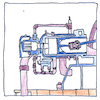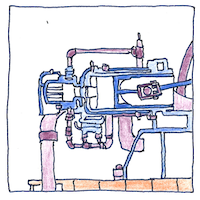Rudolf Diesel
thermodynamics

|
Diesel engine
Rudolf Diesel had studied thermodynamics and tried to develop a Carnot Cycle engine with the best possible efficiency. Compression ignition and direct injection of oil into the cylinder instead of premixing a lighter gasoline with air simplified the cycle but the efficiency of the diesel engine compared to a gasoline engine is simply a result of its higher compression ratio.
Compression ignition
It turns out that Diesel was not the first to build an engine with compression ignition. Diesel might have been inspired by the fire piston, which was patented in Europe in 1807 although it had been in use in South East Asia and the islands of the Pacific since ancient times. Nevertheless, Diesel was not the only person who was inspired. Herbert Akroyd-Stuart created an engine with compression ignition and direct fuel injection (not mixed with air) two years earlier; however, Akroyd-Stuart’s engine operated with lower compression and today is called a “heavy-oil” engine. At any event it shouldn’t be called a “diesel.”
Biodiesel
The first working diesel ran on peanut oil and any diesel engine will run without modifcation on biodiesel, made of vegetable oil and animal fats by transesterification that separates the glycerin and leaves mono-alkyl esters of long chain fatty acids.
Diesel
More bang for the buck moves more metal. Sure to be more to say about it. In the end it seems it all evens out.



Because of the higher compression and higher torque, diesel engines have been built with heavier components, but they have better overall energy conversion efficiencies than gasoline engines. Diesel fuel can cost more, but it has a higher energy density than gasoline. Nevertheless, my money would be on all-electric vehicles, because, even if petroleum fuel generates the electricity, large-scale engines at the power station can run with greater efficiency than engines in vehicles.
See also in The book of science:
Readings in wikipedia: